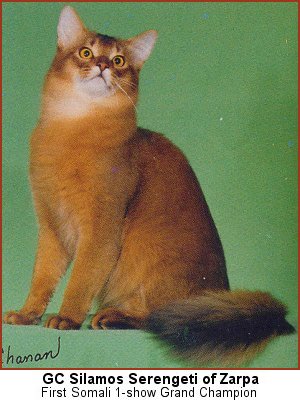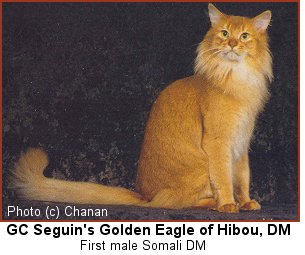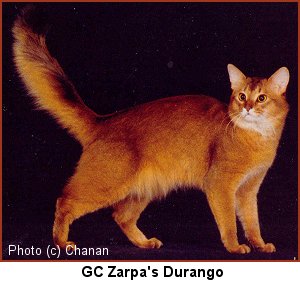Somalis - The First Decade and Beyond
by Debbie & Larry Ritter
From the 1990-91 CFA Yearbook, posted with permission from CFA Page 1 ::
2 ::
3 ::
4 ::
5 ::
6
WHAT IS A SOMALI?
 Somalis are the epitome of everything that most people would ever want in a companion animal. On the one hand they are lively, alert, and actively engaged in everything new that piques their curiosity, and on the other hand when playtime is over, they will seek all the attention and affection that their caretakers are willing to give. A cozy lap is a favorite nap site after a boisterous bout of chasing elusive playmates, real or imagined.
Somalis are the epitome of everything that most people would ever want in a companion animal. On the one hand they are lively, alert, and actively engaged in everything new that piques their curiosity, and on the other hand when playtime is over, they will seek all the attention and affection that their caretakers are willing to give. A cozy lap is a favorite nap site after a boisterous bout of chasing elusive playmates, real or imagined.
Somalis have very resilient personalities and adapt to new people and homes with ease. Other cats and even dogs rarely pose any problems for them. They are easily trained to fetch favorite toys and have an unusual fascination with water.
Somalis usually range in size from 6 to 10 pounds, the males being somewhat larger. Acceptable coat texture varies from thick and woolly to long and silky. The former having a denser and fuller coat, and the latter having less undercoat but longer guard hairs and generally more banks of ticking. Most Somalis’ coats are fairly smooth over the body and are a blend between these two extreme coat types - that is silky and luxuriant, two to three inches in length, non-matting, and easy to care for.
 One remarkable aspect of the Somali is their “foxlike” appearance due to their markings, bushy tail, full breeches, and ruff. They are also very muscular, lithe and athletic.
One remarkable aspect of the Somali is their “foxlike” appearance due to their markings, bushy tail, full breeches, and ruff. They are also very muscular, lithe and athletic.
Like its shorthaired Aby counterpart, the Somali is an active, intelligent, affectionate companion. Being extremely people oriented, Somalis are most “helpful” in assisting people in their day to day activities.
In general, Somalis are larger cats than Abys. In a litter of newborn kittens, a Somali looks decidedly different than his shorthaired cousins. In addition to being a little larger than a shorthaired kitten, the newborn ruddy Somali is born nearly black over the portions of his body that will later be ticked as an adult. The stomach and inside of the legs and chest will be a reddish cream in color.
 In contrast, a shorthaired Somali or Aby is reddish in color, displaying the ruddy coloration of the adult animal. Where as Somali kittens at birth are almost black and show little hint of the rich mahogany undercolor which they will develop as they mature. Somalis are also slower to mature than Abys. With the added coat length of the Somali, ticking often takes longer to manifest itself, and the same can hold true for color.
In contrast, a shorthaired Somali or Aby is reddish in color, displaying the ruddy coloration of the adult animal. Where as Somali kittens at birth are almost black and show little hint of the rich mahogany undercolor which they will develop as they mature. Somalis are also slower to mature than Abys. With the added coat length of the Somali, ticking often takes longer to manifest itself, and the same can hold true for color.
Nothing is more delightful than to watch an impeccably groomed Somali perform in the judging ring. A natural clown, a Somali will show himself to the fullest while playing with any toy a judge chooses to honor him with. Whether in the judging ring, or at home, a Somali shows a zest for life which makes him a wonderful companion and member of the family.
Page 1 ::
2 ::
3 ::
4 ::
5 ::
6
Top
Back
All photographs © by the individual photographers.
Please do not download or copy them without express permission.
© CFA Somali Breed Council - All rights reserved
For questions or comments regarding the site, please contact the Breed Council Secretary
Site design and maintainance courtesy of Ristokat Web Design |